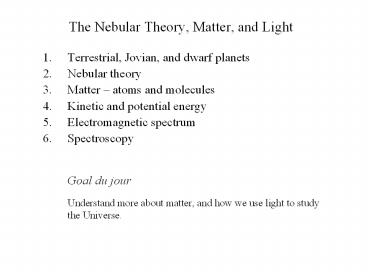The Nebular Theory, Matter, and Light PowerPoint PPT Presentation
1 / 14
Title: The Nebular Theory, Matter, and Light
1
The Nebular Theory, Matter, and Light
- Terrestrial, Jovian, and dwarf planets
- Nebular theory
- Matter atoms and molecules
- Kinetic and potential energy
- Electromagnetic spectrum
- Spectroscopy
- Goal du jour
- Understand more about matter, and how we use
light to study the Universe.
2
Four classes of solar system objects
- Terrestrial planets
- Jovian planets
- Dwarf planets
- Jovian moons
3
Solar System models
- A good formation model should explain all these
things. - ?See details of the Nebular Theory, p79.
- ? Pay particular attention to origin of two types
of planets.
4
The basics of matter
- Atoms
- Often considered the building blocks of matter,
but atoms have internal structure. - Atoms consist of a nucleus, and a surrounding
cloud of electrons. - The atomic nucleus
- Protonsmassive, charge
- Neutronsmassive, no charge
- Electrons
- Low mass, - charge
- of electrons of protons
5
The basics of matter
4 2
Elemental notation He
1H 1 proton (and 1 electron) 2H 1 proton, 1
neutron (and 1 electron) 4He 2 protons, 2
neutrons (and 2 electrons) Isotopes The same
element (proton ), but different masses (i.e.,
different numbers of neutrons). Ex
He Ions Atoms temporarily stripped of one or
more electrons.
3 2
6
The basics of matter
- Molecules are atoms that have been bound together
by mutual attraction. - Simple compounds
- O2, N2
- Complex compounds
- CO2, H2O, C12H22O11 (sucrose), DNA
- Organic compounds
- Contain C-H bonds
7
Phases of matter
Phases Solid Liquid Gas (Plasma)
Solid
Freezing? ?Melting
Sublimation? ?Deposition
Evaporation? ?Condensation
Liquid
Gas
8
Types of energy
- Kinetic EnergyEnergy exhibited by motions
speed, vibrations, rotations. - Potential EnergyStored energy at the top of a
hill, a compressed spring, Emc2 - Radiative EnergyEnergy stored in photons,
technically in each photons magnetic and
electric fields, hence electromagnetism. - TemperatureA measure of how much kinetic energy
is in a sample of molecules
9
Electromagnetic Radiation
- Photon
- A self-propagating packet of pure energy.
- c
- All photons all travel at the speed of light,
the highest speed at which anything in the
universe can travel. - Frequency
- Higher energy photons have a higher frequency.
- Wavelength
- Higher energy photons have smaller wavelengths.
- Types of electromagnetic radiation
- radio? microwave ? infrared ? ROYGBIV ?
ultraviolet ? x-rays ? Gamma rays
10
Spectra
- Spectrum
- A graphical display of the different kinds of
photons in a beam of radiation. - It might be portrayed as a line-graph, or (if
visible light) as a multicolored display. - This kind of smoothly varying, peaking spectrum
is called a continuum spectrum. - Continuum spectra are produced by opaque, glowing
objects.
11
Continuum spectra
- The wavelength peak of a spectrum is affected by
the glowing objects temperature. - Very hot objects glow blue.
- ?We can take the temperature of objects by
looking at them!
12
Electrons in atoms
- To understand the other kinds of spectra, we must
first understand how electrons in atoms interact
with photons. - Electrons can jump from one level to another in
atoms. - An electron dropping towards the atom releases
energy in the form of a photon. - An electron must absorb a photon in order to jump
to a larger orbit. - Every different kind of element has a different
set of electron orbit sizes. This will be useful.
13
Types of spectra
- Continuum spectrum
- An opaque object will produce a continuum
spectrum. - Emission spectrum
- A transparent gas cloud, excited by some energy
source, will produce an emission spectrum. - Absorption spectrum
- A continuum source, with a transparent gas cloud
in front it, will produce an absorption spectrum. - Chemical analysis
- Since every atom has its unique set of electron
orbits, each atom has a characteristic spectrum. - ?We can learn about the composition of gas
clouds, or planets, or stars in space by looking
at them!
14
Gas discharge tubes
- Gas normally does not conduct electricity
- 1)High voltage applied across gas drives
electrons across the gap. - 2)Electrons ram into the gas atoms in the tube,
exciting the bound electrons (i.e., gives the
electron energy). - 3)The bound electron settles back to its ground
level, releasing the stored energy as a photon. - 3)Repeat

